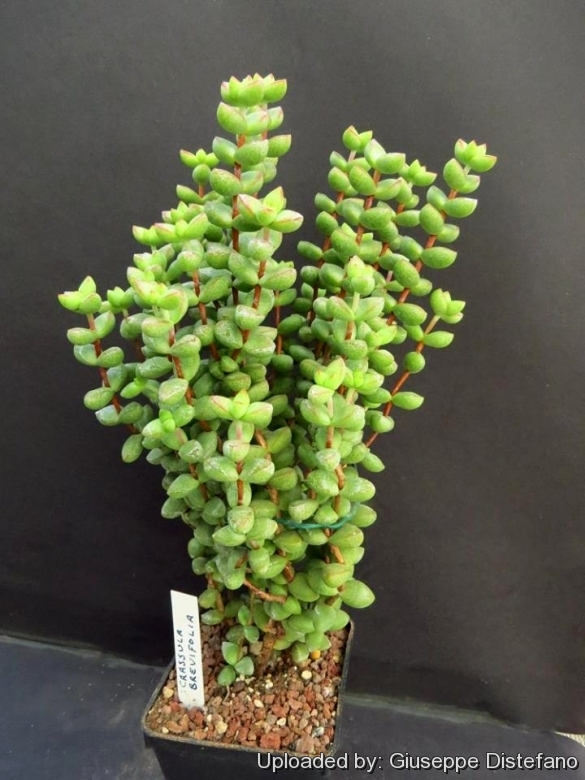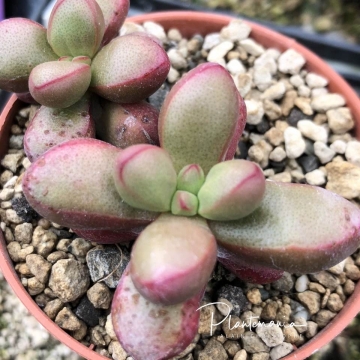




Your support is critical to our success.

Origin and Habitat: Crassula brevifolia is found from south-western Namibia through Namaqualand to Vanrhynsdorp (Northern Cape, Western Cape, South Africa).
Habitat and ecology: Succulent Karoo, among rocks.
Synonyms:
- Crassula brevifolia Harv.
- Crassula Crassula Dinter
- Crassula flavovirens Pillans
- Crassula montis-draconis Dinter
- Crassula pearsonii Schönland
Crassula brevifolia Harv.
Fl. Cap. (Harvey) 2: 339
Synonymy: 6
- Crassula brevifolia Harv.
- Crassula Crassula Dinter
- Crassula flavovirens Pillans
- Crassula montis-draconis Dinter
- Crassula pearsonii Schönland
- Crassula fragillima Dinter
Crassula brevifolia subs. psammophila Toelken
J. S. African Bot. 41(2): 98. 1975
ENGLISH: rockslab crassula
AFRIKAANS (Afrikaans): rotsplaatplakkie
Description: Crassula brevifolia is a much-branched shrublet 30-50 cm tall, with woody stems and old leaves deciduous. Two subspecies are recognized, the nominate form and the smaller Crassula brevifolia subs. psammophila.
Stems: Stems subdichotomously branched. Branches green, round, 6 mm in diameter with intemodes visible between the leaves, Older branches woody, with reddish-brown flaking bark.
Roots. Fibrous.
Leaves: Very fleshy, connato-perfoliate, almost triangular and flattened in section, variable in shape, elliptic to linear-elliptic, (10-)20-35(-50) mm long, (2-)4-6(-18) mm wide and about as thick as broad, curved upwards abruptly constricted into to a blunt tip, spreading and bent upwards, glabrous, green often with a grey bloom, changing to yellow, red or purple, upper face flat to convex, lower face convex or keeled, tip acute, hydathodes on upper surface and margins. Margins horny at edge. Old leaves deciduous.
Inflorescences: Terminal, rounded or domed, laxly few-flowered thyrses, the foliage usually passing gradually into bracts. Peduncle (3-)10-50(-80) mm long.
Flowers: Lemon-yellow, rarely white, with a papillose ovary, and a pronounced, not at all pleasant honey-smell. Sepals (calyx lobes), connate, triangular, 0,7-1.5 mm long, rather thin, obtuse, ridged, somewhat fleshy, glabrous, green tinged red. Corolla tubular, fused basally for 0,6-1,2 mm, white to reddish tinged. Petals oblong-elliptic 3-4(-5) mm long, creamy-white or yellowish, rounded, erect or even strongly recurved at the tip, with or without a small mucro behind the apex. Stamens 2.5-4 mm long, attached to the short corolla-tube, about three-fourths the length of the petals Filaments white, subulate, anthers ovate, pollen black or yellow. Carpels greenish, about the length of the stamens, ovaries gradually passing into the short, slightly recurved styles, minutely scabrous all over and minutely ciliate along inner margin. Styles one third length of ovary. Squamae oblong to square, 0,6-0,8 x 0,5-0,9 mm, truncate, rarely emarginate, somewhat constricted downwards, fleshy, yellow to bright orange.
Blooming season: Autumn (March to April).
Seeds: Extremely small, weighting bout 0,01 mg. These small seeds (also known as dust diaspores) can be blown about like dust particles without any special devices for buoyancy. In this species, enormous numbers of seeds are produced at the cost of fewer, larger sized seeds . Because this plant occur abundantly in the arid areas and has specific habitat requirements, the production of increased numbers of seeds is essential to enhance the probability that at least some seeds will reach a favourable germination site. Except for their small size, these diaspores generally lack other appendages to further promote dispersal by wind. Several genera of the Crassulaceae, e.g. Crassula, Tylecodon and Cotyledon, occouring in the arid areas of southern Africa have very tiny dust-like seeds. The production of numerous dust-like seeds by desert species serves as an escape strategy to prevent mass consumption of seeds. These tiny seeds are carried by the wind to cracks and furrows in the soil and are then covered with fine soil particles.
Subspecies, varieties, forms and cultivars of plants belonging to the Crassula brevifolia group
 Crassula brevifolia Harv.: intemodes visible. Leaves 20-35 mm long, curved upwards, green with a grey bloom, changing to yellow, red or purple. Distribution: Namibia through Northern and Western Cape (South Africa).
Crassula brevifolia Harv.: intemodes visible. Leaves 20-35 mm long, curved upwards, green with a grey bloom, changing to yellow, red or purple. Distribution: Namibia through Northern and Western Cape (South Africa).- Crassula brevifolia subs. psammophila Toelken: smaller (up to 200 min high) the intemodes not visible. Lhe leaves are brownish-red without bloom. Distribution: Grootinis and the Orange River.
Bibliography: Major references and further lectures
1) Foden, W. & Potter, L. 2005. Crassula brevifolia Harv. subsp. brevifolia. National Assessment: Red List of South African Plants version 2015.1. Accessed on 2015/12/25
2) Doreen Court “Succulent Flora of Southern Africa” CRC Press, 01 June 2000
3) Trees in South Africa, Volume 32-35, Tree Society of Southern Africa, 1980
4) Urs Eggli “Illustrated Handbook of Succulent Plants: Crassulaceae” Springer Science & Business Media, 06 December 2012
5) J.P. Roux “Flora of South Africa”, 2003
6) Ernst Van Jaarsveld, Ben-Erik Van Wyk, Gideon Smith “Succulents of South Africa: A Guide to the Regional Diversity” Tafelberg, 2000
7) James Cullen “The European Garden Flora Flowering Plants: A Manual for the Identification of Plants Cultivated in Europe, Both Out-of-Doors and Under Glass” Cambridge University Press, 11 August 2011
8) Higgins. “Crassulas 03 cultivation”. 67 1949
9) Graf. “Exotica” series 4. edn 12. 1: 871 1985
10) Rowley. “Crassula, a grower's guide”, 93 2003
11) Karen van Rheede van Oudtshoorn, Margaretha W. van Rooyen “Dispersal Biology of Desert Plants” Springer Science & Business Media, 09 March 2013
12) “Annals of the South African Museum: Annale Van Die Suid-Afrikaanse Museum”, Volume 9, South African Museum, page 47, 1911
13) Werner Rauh “The Wonderful World of Succulents: Cultivation and Description of Selected Succulent Plants Other Than Cacti” Smithsonian Institution Press, 1984

Crassula brevifolia Photo by: © Plantemania
The gallery now contains thousands of pictures, however it is possible to do even more. We are, of course, seeking photos of species not yet shown in the gallery but not only that, we are also looking for better pictures than those already present. Read More...
Cultivation and Propagation: Crassula brevifolia is a good beginner plant, fast growing, easy to propagate from cuttings and not prone to pests. It grows under a wide variety of climatic conditions provided it is planted in a well-drained situation given adequate water but not over-watered. They are often grown in bonsai pots and trimmed to appear as small trees. C. brevifolia plants will branch at the tips and can be used as a low, informal hedge.
Growth rate: It is a pretty fast grower.
Soil: Plants grow well in a well-drained mineral soil.
Pots: It needs a relatively shallow pot to accommodate its fibrous roots and provide a very good drainage. It may stay in the same pot for many years.
Watering: It needs moderate water – not too wet nor too dry from autumn to spring with regular water in summer (careful watering required in winter), fairly drought tolerant elsewhere.
Fertilization: Light fertilizer seems to boost its growth whenever additional water is given. Feed it during the growing season with a fertilizer specifically formulated for cactus and succulents (high potash fertilizer with a dilute low nitrogen), including all micro nutrients and trace elements diluted to ½ the strength recommended on the label. It thrive in poor soils and needs a limited supplies of fertilizer to avoid the plant developing excess vegetation, which is easily attacked by fungal diseases.
Special need: Provide very good ventilation. Nearly all problems occur as a result of overwatering and poor ventilation, especially when weather conditions are dull and cool or very humid.
Exposure: It cannot take direct sun in summer but generally needs sun part of the day to bloom. In deep shade it gets pretty weak and leggy and eventually rots and dies. As house-plants, give crassulas up to 6 hours a day of sun.
Pest and diseases: It does not suffer from pests, other than the occasional mealybugs. Protect against frost.
Maintenance: After growing for several years tends to become untidy resulting in thick tops and bare stems at the bottom. Without the pinching and trimming these succulent plants form new branches near the top. To encourage shrubbier growth, pinch off a few leafs at the top or restart it from cuttings.
Hardiness: Outdoors in frost free areas, indoors all other zones
Propagation: Seeds/ Stem cuttings. Sow seeds in autumn. Place cuttings in clean river sand, mist every three to four days, roots should appear within 2-3 weeks.
| Your Actions | |
|---|---|
| Back to Crassula index | |
| Back to Crassulaceae index | |
 |
Back to Succulents Encyclopedia index |
Privacy stantement - Terms and conditions - How to cite - About us - Feedback - Donate



